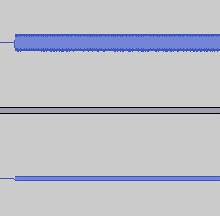 Duplex theory, as proposed by Lord Rayleigh, describes sound reaching the two ears as Interaural Time Differences (ITD) and Interaural Level Differences (ILD).
Duplex theory, as proposed by Lord Rayleigh, describes sound reaching the two ears as Interaural Time Differences (ITD) and Interaural Level Differences (ILD).In the figure to the right, the path difference from the source to each ear is different, the distance from the source to the left ear is greater than the distance of the source to the right ear. The difference between these two path differences represented as time gives us the Interaural Time Difference (ITD).
The ITD is the dominant cue for frequencies at 1.5kHz or below and the ILD is more dominant for frequencies greater than 1.5kHZ. The ILD is produced due to shadowing of the head and this only occurs for greater frequencies that do not diffract around the head, creating a shadow similar to the shadow casted by light.
(image above from SternWangBrown, chapter 5, Binaural Sound Localization - Found in Links)
An experiment was conducted to verify Rayleigh's Duplex theory within an anechoic environment, having the source and binaural head a distance of 1.75 meters apart. Using four pure tones created in Csound for 125kHz, 250kHz, 500kHz and 1000kHz and the source directed at 0 degrees, 10 degrees, 30 degrees, 50 degrees, 70 degrees and 90 degrees, Rayleigh's Duplex theory for sound localization was verified.

The graph on the left is an image of the left and right binaural microphones detecting a 1000kHz pure tone single source signal approximately 1.75m away (top -left ear, bottom - right ear). As you can clearly see from this image, the two channels are out of phase with one another and that the bottom channel is delayed in comparison to the channel above. The ITD of this complete signal is 0.735milliseconds and is the maximum ITD achievable by the system since the front center of the dummy head is perpendicular to the source.

The value 0.735milliseconds could be too great a ITD, "the maximum possible ITD is about 0.66milliseconds for a typical human head size" (Computational Auditory Scene Analysis, Chapter 5, Binaural Sound Localization, DeLiang Wang and Guy J. Brown(eds.) 2005). Another paper states "a sound that is at 90 degrees to the right will create an ITD of about 0.7milliseconds" (Cochlea, Binaural Hearing, Ruth Y. Litovsky, Ph.D., Feb, 2008), showing that the differences in the average human head size have created a uncertainty in the value for the maximum possible ITD. If this value is too great, the microphones will have to be placed deeper into the dummy head to decrease the distance that they are space apart.

When comparing the binaural signal of 125kHz and 1000kHz at an angle from the source of 90 degree, the detected signal clearly shows how the ILD differs in frequency. The 125kHz signal is the picture on the right and 1000kHz signal is the picture below on the left. When the frequency of the signal climbs above 1.5kHz, the ILD will dominate as the ITD's will be a lot smaller until they are almost negligible.

The physics behind this phenomena explains that as the frequency of the source increases, the waves will be much closer together. When the waves are much closer together, there ability to bend around objects becomes weaker. Of course, the size of the object and the frequency of the source have a diffraction relationship, but binaural perception has a standard object size, the average human head. There will be slight differences for each individual, as each individual has their own unique head shape and size, creating their own unique frequency shadow that differs the intensity at the obscured ear ever so slightly.
(picture above - http://www.gain11.com/ProAudio/HaasEffectPrecedenceEffect/tabid/158/Default.aspx)
The experiment was carried out using Bandpass Noise for frequencies 125Hz to 4kHz. The results are displayed in the graph below, showing how the Interaural Time Difference decreases slightly as the center frequency is increased.

